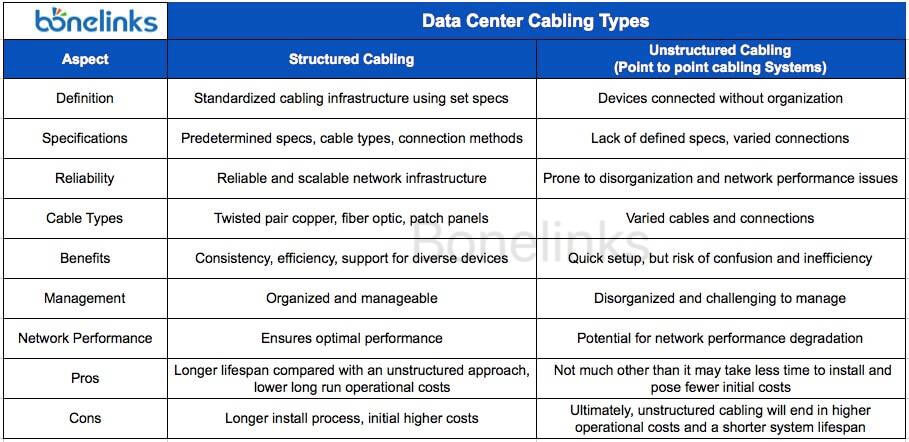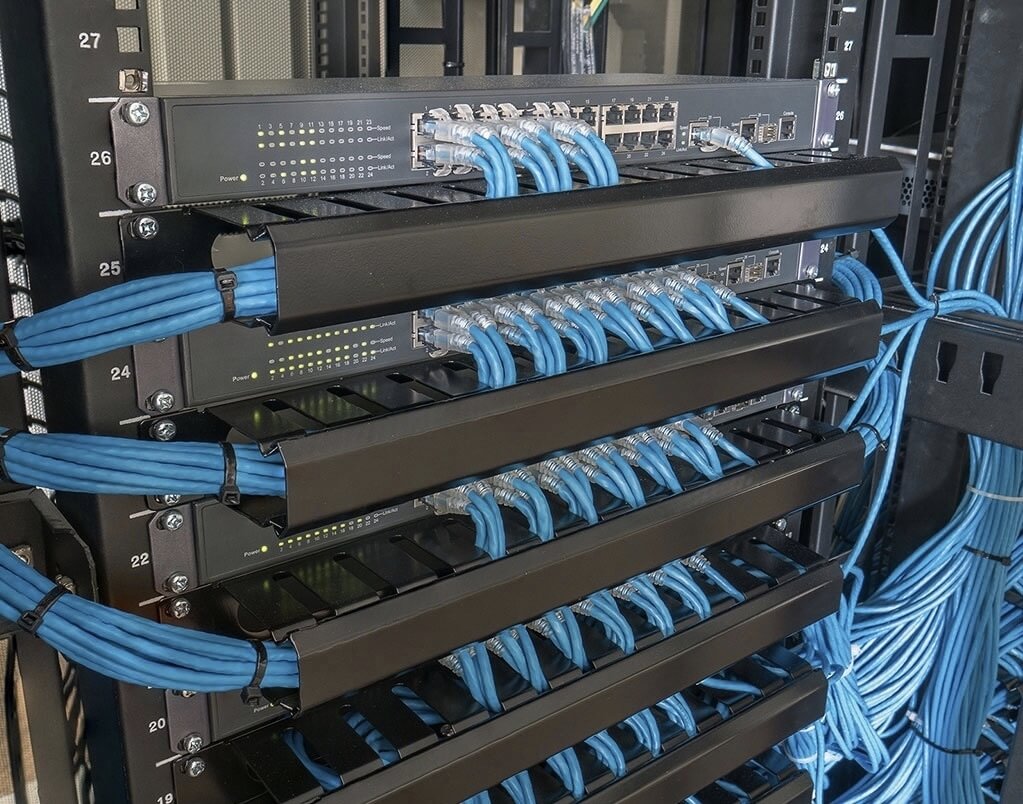Data center cabling involves the interconnection of data, voice, and video cables within a data center environment. In this article, we will discuss the fundamental principles of data center cabling.
What Is Data Center Cabling?
The physical aspect of linking every element within a data center is known as data center cabling. Establishing proper cabling in data centers is of utmost importance, as it ensures a structured and optimized environment that facilitates efficient performance.
Data Center Cabling Types
There are two types of data center cabling: structured cabling and unstructured cabling.

Data Center Cabling Standards
Data center cabling standards in the industry ensure both safety and the foundation for constructing an integrated infrastructure. Simultaneously, they offer directives to uphold cable performance at elevated levels for the foreseeable future. Here, we present three prevalent data center cabling standards.
- ANSI/TIA-942: This standard delineates data center-specific functional zones, setting forth minimal recommendations for space and pathways, distances between backbone and horizontal cable mediums, redundancy, cable management, and environmental considerations.
- ISO/IEC 24764: Drawing from TIA-942 and EN 50173-5, this global standard specifies data center cabling. It references ISO/IEC 11801 and supplementary data center-related information.
- ANSI/BICSI 002-2014: This standard offers directives for data center design and operation, encompassing planning, construction, commissioning, protection, management, and maintenance. It also addresses cabling infrastructure, pathways, spaces, modular and container-type data centers, energy efficiency, and introduces an availability class structure to assess reliability.
Data Center Cabling Best Practices
The expansion of data centers on the outskirts of densely populated areas is becoming more prevalent to enhance performance by minimizing latency for end users. To expedite construction and manage expenses, architects are streamlining data center designs. Consequently, developers and proprietors of these facilities are searching for structured data center cabling solutions that provide the following advantages:
- Repeatability: Enhances design efficiency and cost estimation accuracy.
- Ease of Installation: Reduces labor expenses and accelerates construction timelines.
- Reliable Performance: Ensures optimal functionality without unnecessary expenditures.
Within the domain of data center construction, several factors align with these criteria of repeatability, installation convenience, and reliability. Let’s delve into some best practices related to cable management within hyperscale data centers:
- Cable Tray Fill Ratio: Adhere to the National Electrical Code’s Article 392, which recommends not exceeding a 50% cable tray fill ratio.
- Cable Tray Dimensions: Opt for trays with dimensions of at least 18″ wide and 4″ deep, or ideally, 24″ wide and 4″ deep, to accommodate future expansions. Reserve 12″ wide and 2″ deep trays for micro data centers or confined IT closets.
- Fiber-Centric Design: Construct cable pathways with the anticipation of accommodating 100% fiber cables, supporting the necessary 400G connection speeds for applications like AI, ML, and 5G networks.
- Ceiling-Suspended Conveyance: Whenever possible, suspend cable trays from the ceiling instead of utilizing a Top of Rack (ToR) mount. This facilitates cabinet movement, additions, or relocations without disrupting the cable pathway.
- Pre-Manufactured Turns: Incorporate pre-manufactured turns to maintain appropriate cable bend radii, particularly for fiber optic cables. This practice reduces labor costs, eliminates cable-damaging sharp edges, and is especially valuable in cleanroom environments.
- Segregation of Cables: Separate low voltage and fiber optic cables from high voltage power lines. Employ basket trays for the former and sturdy steel or aluminum trays for the latter, either parallel or in separate tiers.
- Consistent Jacket Color Coding: Implement a standardized cable jacket color code for different cable types within the tray, such as copper, fiber, telecommunications, Power over Ethernet (PoE), and high voltage power lines. This aids easy identification, expansion, and repairs.
By adhering to these data center cabling best practices, hyperscale data centers can achieve efficient organization, streamlined installations, and reliable performance to meet the demands of modern technology requirements.
Data Center Cabling Solutions
Cabling systems form an integral component of data center design, and Bonelinks presents an extensive array of fiber optic cabling solutions tailored to fulfill the evolving network requirements within your data center. These solutions encompass pre-terminated fiber MPO/MTP cables, Direct Attach Cables (DACs), Active Optical Cables (AOCs), and high-speed optical transceivers. Irrespective of the scope or context of your infrastructure implementation, these solutions offer the swiftness to connect and manage your network assets with efficiency.
Product Overview:
| Product | Description |
| 10G SFP+ Transceiver | 10GBASE-SR, 10GBASE-LR, 10GBASE-LRM, etc. |
| 10G SFP+ BiDi Transceiver | 10GBASE-BX10, 10GBASE-BX20, etc. |
| 10G SFP+ CWDM/DWDM Transceiver | 10GBASE-CWDM, 10GBASE-DWDM |
| 100G QSFP28 Transceiver | 100GBASE-SR4, 100GBASE-LR4, etc. |
| DAC Cable | 10G SFP+ DAC, 25G SFP28 DAC, etc. |
| AOC Cable | 10G SFP+ AOC, 25G SFP28 AOC, etc. |
| High-density MPO/MTP Cable | MPO Trunk Cable, MPO Breakout Cable |
| Fiber Patch Cable | Singlemode, OM2, OM3, OM4, OM5 |
Bonelinks’s data center cabling solutions extend beyond products; we also provide an array of services to support your cabling requisites. Our team of adept professionals can aid in devising and deploying a tailored cabling solution that aligns with your distinct requirements. Furthermore, our technical support ensures you have the necessary resources to uphold the seamless operation of your network.
Conclusion
Data center cabling is an indispensable element for businesses reliant on efficient data transmission. Familiarizing yourself with diverse cabling types empowers you to select the ideal solution to meet your specific requirements. Our comprehensive Standards Guide offers insights into the latest cabling standards, empowering you to make informed choices regarding your cabling infrastructure. Stay tuned for more valuable content centered around data center cabling!
Bonelinks stands ready to cater to data center operators with an extensive array of transceivers and cabling solutions. Our offerings encompass optical transceivers, DACs, AOCs, fiber cables, and high-density MPO/MTP cables. With our dependable and cost-effective data center cabling solutions, Bonelinks has successfully assisted numerous clients worldwide. We’re committed to optimizing your IT investments, ensuring you can focus on your core business objectives.




